Submissions of 303rd Bomb Group related stories and articles are most welcome.



October 23, 2011
Volume III, Issue 10
www.303rdBG.com
303rd BG Meets in St. Louis
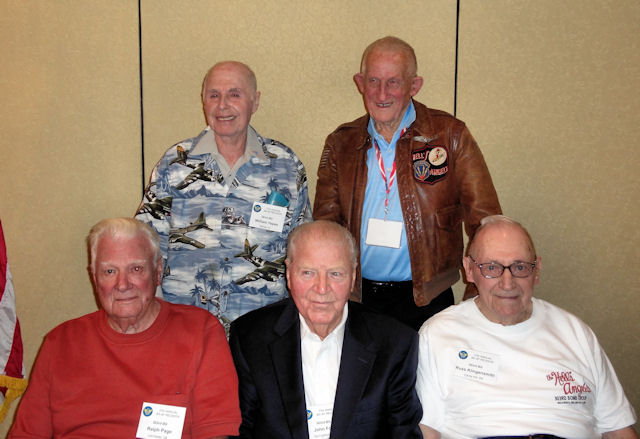
The total 303rd BG attendance was 23, far from what we had at past reunions. Despite the small numbers, everyone had a great time and renewed old friendships. We all plan to meet again next October in San Antonio. We sincerely hope you will join us.
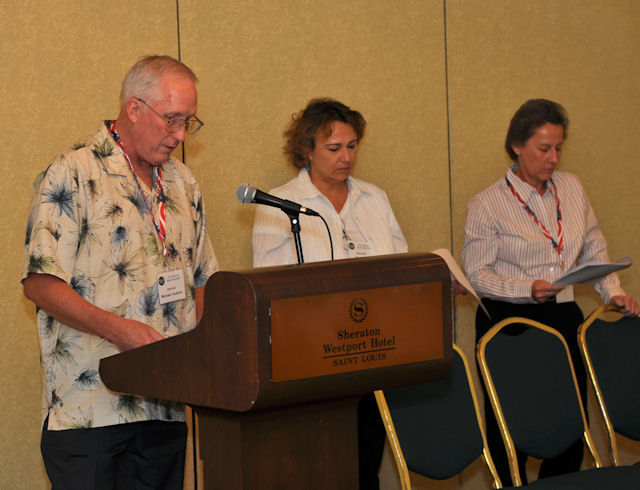
Since we met in Tucson in July 2010, we have lost 92 of our veterans. Reading their names at a very emotional Memorial Service are Mike Faulkner, son of Lee Faulkner, Kim Lewis, daughter of Russ Klingensmith and Eleesa Faulkner, daughter of Lee.
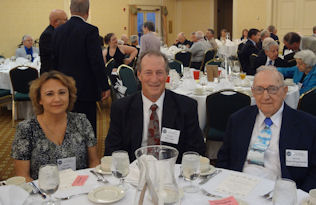
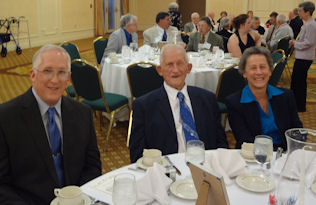
Russ Klingensmith with daughter and son-in-law Kim and Karl Lewis.
Lee Faulkner with son Mike and daughter Eleesa.
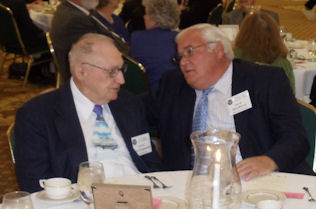
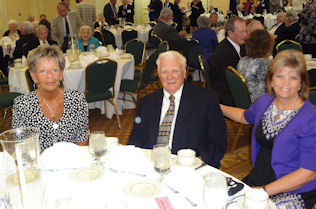
Russ Klingensmith and Gary Moncur talking about Oschersleben.
Ruth Collins with Ralph Page and his daughter-in-law Melanie.
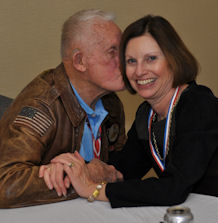
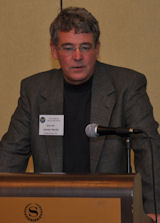
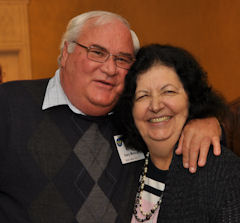
Lee Faulkner flirting with Carol Kyle Sage.
Jay Hardy conducting the Rendezvous Dinner.
Gary and Susan Moncur.
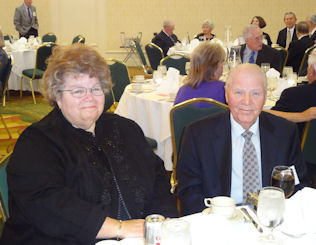
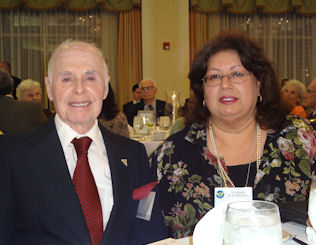
John Ford with daughter Linda - William Yepes and daughter Esther.
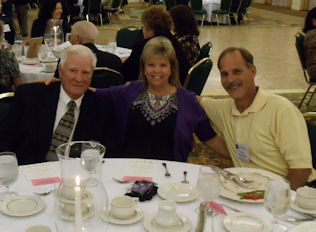
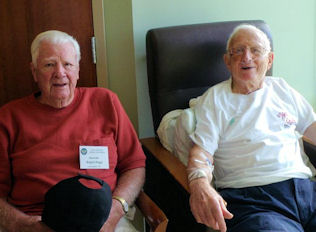
Ralph Page with Melanie and his son Rocky. Al Oswald had an accident in St. Louis just prior to the reunion. He had several 303rd visitors in the hospital, including his friend Ralph.
by Jim Hickey
[originally published in the March 1990 Hell's Angels Newsletter]
The mission on July 16, 1944 began like most. At 0330 hours an operations sergeant opened the front door of the Nissen hut, stepped inside and said:
"OK gentlemen ...four-o'clock breakfast, five-o'clock briefing"
He walked twenty feet further toward the far end of the barracks and repeated the wake-up call in the same apologetic but firm tone. In this hut the pilots, navigators and bombardiers for two B-17 crews began to stir and prepare for eight or nine hours in the air, mostly over enemy territory. Similar wake-up calls were going on in the huts where the flying engineers, radio operators and gunners were sleeping.
Outside, it was dark and pleasantly cool. The stars shined brightly in the sky. Some heading for the mess hall rode bicycles but most walked the quarter mile. Breakfast was eaten quietly and with some apprehension about the day ahead.
Pilots, navigators, bombardiers and gunners each had their own briefing because they had different jobs in the course of the mission. Their briefings were designed to prepare each to do his job. Pilots began arriving at their briefing room about ten minutes before the scheduled time. It was a rather large room with several rows of backless benches divided down the middle by an aisle. When full, it would contain the 110 pilots and copilots who, with their crews, would fly 55 B-17's in today's mission. The 303rd Bomb Group with its four Squadrons, the 358th, 359th, 360th and 427th, was responding to an Eighth Air Force Bomber Command order for a MAXIMUM EFFORT. This meant ... get every aircraft possible over the target with all the bombs they can carry.
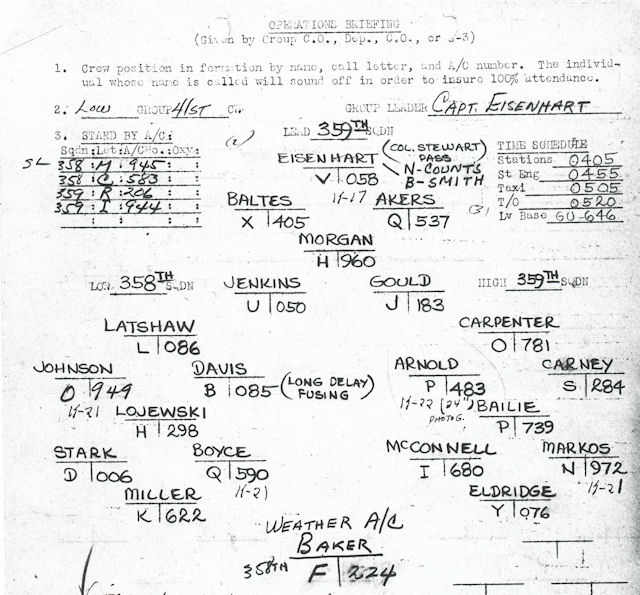 41st Combat Wing, Low Group Formation Diagram for Mission #204, 16 July 1944, to Munich, Germany
41st Combat Wing, Low Group Formation Diagram for Mission #204, 16 July 1944, to Munich, GermanyThe wall behind the slightly elevated stage at the front of the briefing room was covered by a draw-drape concealing a huge map of northern Europe showing the route that the 303rd along with many other groups would take to the target. At the left of the stage, a large blackboard on an easel provided aircraft and formation assignments for the mission. White T's representing airplanes were painted on the blackboard in a pattern simulating the formation. Pilot's names were chalked in above the T's and a letter and the last three digits of an aircraft's serial number were written to the left and right of the T stems respectively.
Lieutenants Walt Carney and Jim Hickey took seats toward the front of the room and began copying information displayed. They noted that they would be flying off the low flight leader's right wing in aircraft S-284. The B-17 that they would fly today also had a name like most. Some were very imaginative. The name painted on the nose of S-284 was Ain't Misbehavin. Although the mission planners used official designators, the crew knew them by their names.
Conversations among the plots subsided as the Briefing Officer took the stage and faced them. There was never any delay in that somewhat dramatic moment when the drapes were drawn and the target was announced. Usually there was no response from those listening unless the target, like today's, was regarded as a rough one. This was the third consecutive trip for the 303rd to heavily defended Munich. There were some subdued grunts and moans.
Once the target was known, the briefing staff provided information about the route, wind speed and direction, cloud conditions, type and number of enemy fighters expected along the route, type of friendly fighters and rendezvous times, temperature at altitude (usually about 45%) and flak strength and accuracy anticipated in the target area. Instructions were given about forming the Group after takeoff and departing for Germany. Times were provided; times for leaving the English coast, reaching the IP (Initial Point, the beginning of the bomb run which was a straight line to the target about fifty miles long), even a time for turns that the formation would make enroute. Then, of course, there were times for checkpoints on the way home and arrival at base. The times for the crews to be at their aircraft, start engines, taxi and takeoff also were given and finally, everyone synchronized watches.
At the Equipment Room, flight clothing, oxygen masks, throat mikes, head sets, escape kits (in case you survived being shot down over enemy territory) and of course, parachutes. Mae Wests were either put on or carried in a bag to the airplane. Flak helmets and vests, which were worn on the bomb run and in the target area, were always left in the airplane. When crew members were ready, trucks waiting outside took them to their aircraft.
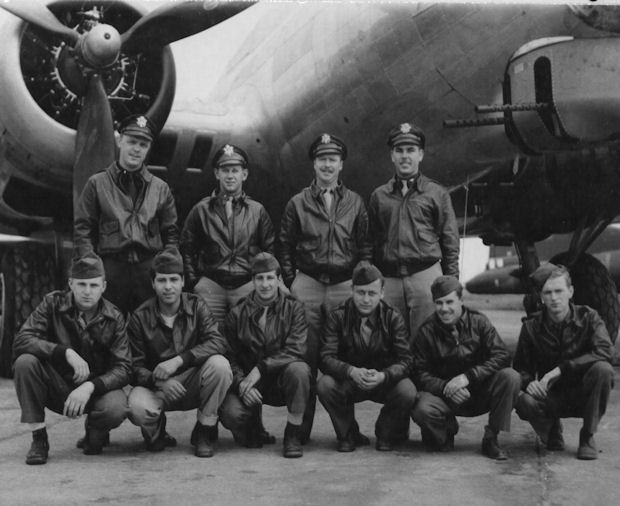
(Back L-R) 2Lt Albert R. Taylor (N), 2Lt James A. Hickey (CP),
2Lt Thomas E. Cooney (B), 1Lt Walter J. Carney (P)
(Front L-R) T/Sgt Albert. Foster (R), S/Sgt William Encinas (WG),
S/Sgt Emil Kayrallah (BTG), S/Sgt Clarence E. Howe (TG),
Sgt Jackson L. Henderson (WG), T/Sgt Harold L. Turner (E)
Carney's crew assembled at a hardstand in the 359th Squadron dispersal area where Ain't Misbehavin was parked. The airplane, bombs, ammunition and machine guns were ail checked. Engines were started at 0720 and the crew radio checked. A few minutes later, according to the taxi sequence diagram received at briefing, they followed P-483 from a nearby hardstand joining the long line of B-17's heading for takeoff.
Aircraft ahead were disappearing into the early morning sky, and when P-483 was far enough along in its takeoff, Carney rolled Ain't Misbehavin onto the runway and eased the throttle forward. The sound of the four Wright 1820 engines, totaling 4800 hp, rose from a soft flutter to a roar and the ship moved rapidly forward. As it rumbled down the runway gaining speed, the tail lifted off then momentarily Ain't Misbehavin thundered into the air with its 2880 gallons of gasoline, ten 500 pound GP bombs and nine crewmen. It climbed 10,000 feet in an upward spiral where it joined the growing formation of the 303rd Bomb Group.
Bomb groups from the bases at Kimbolton and Grafton-Underwood, together with the 303rd, located at Molesworth, formed the 41st Combat Wing, which consisted of approximately 175 Flying Fortresses. The 41st, along with other Wings accounted for the more than 1200 four-engine bombers that were almost daily bombing Germany during the second half of 1944.
The 303rd concluded its assembly and headed toward Germany at 0904 as scheduled. On the way to departing the English coast, the three Groups identified each other and formed into the 41st Combat Wing. It was a beautiful day and the sun was shining brightly. The higher you were the brighter it was. It danced and flashed off the many bright silver planes in the formation. Early in 1944 the practice of camouflaging new aircraft with paint was discontinued. The gain in flying speed outweighed any loss in concealment. The Germans did not have to see the aircraft to shoot at them. They were tracking them and firing their 88's and 155's with radar. Enemy fighters were not fooled by the paint, either. Besides, painted or not, they had to stay in formation and that was where they were initially attacked.
When the 303rd left the assembly point, it began a slow climb to 28,000 feet, the bombing altitude. The higher you were above 10,000 the more critical was the need for oxygen. It was fatal to be off oxygen for three minutes at 28,000 feet. On long missions, like the one today, crews were above 10,000 feet and on oxygen for five hours or more. The masks were pulled snug against the face to form a good seal and sometimes you sweated into them. After five hours they were tiresome and a bit of a nuisance. Masks were usually not worn by crew members until they reached 10,000 feet. On board Ain't Misbehavin it was time for an oxygen check.
Carney and Hickey had their masks on. Hickey pressed his mike button and said:
"Copilot to crew... oxygen check"
Turning his head left, he looked back at S/Sgt Harold Turner, engineer and top turret gunner. Turner's usual position, when he was not in the turret, was in the middle of the flight deck just behind the pilot and copilot.
Turner replied: "Top turret OK"
The rest of the crew followed ...
Philadelphian Lt A. Ray Taylor, said: "Navigator OK"
Togglier S/Sgt Ray Tartaglia reported: "Togglier OK"
S/Sgt Al Foster, radio operator said, "Radio OK"
Sgt. Emil Kayrallah said simply: "Ball turret"
Willie Encinas reported. "Waist OK"
And last, Clarence Howe from Minnesota commented: "OK in the tail"
Routinely after departing the English Coast, gunners were advised to test-fire their weapons. For the next few minutes, the 50's from various places in the airplane stuttered short bursts to verify their readiness. All crew members were told to stay alert for enemy fighters.
As the formation neared the continent, it turned and appeared headed for Cologne. Germans knew that it was not that simple, they were not really going to Cologne... were they? They could not disregard this possibility because it had frequently been a target. As the stream of bombers got closer their uncertainty grew... they must alert their fighters... the city's defenses. Well short of Cologne the formation turned again. This time Frankfurt could be imperiled... certainly precautions must be taken! Next it looked as though Stuttgart might be the target. Mission planners at Bomber Command employed such strategy in an effort to prevent the enemy from guessing the target for as long as possible. At some point, of course, the Germans concluded that the target was Munich and activated their defenses with certainty.
Over enemy territory the radio operator manned one of the two waist guns so on the bomb run Encinas and Foster would be busy throwing chaff out of the airplane. Chaff was thin aluminum strips intended to interfere with the antiaircraft radar.
Along the route some clouds had been encountered. Mostly they were well below the formation. Now there were some high cirrus. When the IP was reached and the Wing headed straight for Munich, the clouds became solid. Only the element leader's aircraft to the left was visible. Bombing would be by radar because the target was obscured. Dropping off the lead ship, Tartaglia said: "Bombs away" as was customary and the ship lurched upward a little suddenly free of 5000 pounds. Moments later there was a substantial thud and Ain't Misbehavin shuddered and rumbled like a car with a flat tire.
Hickey looked to the right out his side window and saw what looked like a stream of smoke trailing off the right wing behind the outboard engine (#4). Then from the waist, Encinas and Foster reported a strong gasoline odor. Number 4 prop was feathered. The airplane was under control and everything seemed reasonably normal. The impossibility of what had happened took a few moments to accept. An antiaircraft shell, probably an 88, had penetrated the right wing between #3 and #4 engines and about midway between the leading and trailing edges of the wing. The shell went completely through the wing! It went through #4 main tank and severed lines to the Tokyo tanks in the right wing tip, emptying both. This was a direct hit! And they survived it! About 800 gallons of gasoline was lost. It was learned later, on the ground, that the hole was about 18" in diameter and that the shell had just nicked the main spar in the wing.
Earlier in the war the Germans used antiaircraft shells that exploded on impact. Today they were using time fuses which detonated the shell at the end of the time that the fuse had been set for – the time that it was expected to take to reach the formation. Sometime later they began using proximity fuses which detonated when they came close to a substantial metal object such as an airplane.
The reduced airspeed caused by the loss of #4 engine immediately dropped Ain't Misbehavin out of the Group formation leaving it alone on instruments. Carney asked Taylor about getting back to the base. After some calculations involving headwinds, reduced airspeed, and remaining fuel, Taylor estimated that they would come down substantially short of the North Sea and with only three engines they would be prey to German fighters all the way. D-Day had occurred only six weeks earlier and virtually all of the Continent was enemy territory. Taylor suggested Switzerland and Carney asked for a heading.
Miraculously and a testimonial to the Boeing Aircraft Corporation and its workers, Ain't Misbehavin climbed on three engines from 28,000 feet to over 32,000 breaking into the clear over northeastern Switzerland. No Swiss fighters came up to meet them as they had often been told at briefings would happen and as they neared Zurich they encountered antiaircraft fire. Taylor did not have any maps that went south of Switzerland, but he gave Carney a heading to the south and the journey continued. Everything was visual and they crossed the Ligurian Sea shoreline a little west of La Spezia, Italy, which was German held. They fired at Ain't Misbehavin but were far out of range. Carney had been letting down since leaving Switzerland and concern now focused on where the front-line was in Italy. No one knew. They were from England and had not followed the Italian campaign that closely. Hickey and Foster attempted to get an answer to Mayday calls but wound up talking to each other. Then #2 engine expired due to lack of fuel ...they were running out of gas!
Carney and Hickey saw an airfield a few miles inland from the west coast of Italy and headed immediately for it not knowing whether it was German or American. As they got closer they recognized C-47's on the field and after landing learned that it was a hospital air-evac squadron.
Eight days later they were told to fly the airplane to Bari on the east coast of Italy where there was a large repair depot. Carney and Hickey took Ain't Misbehavin off that short dirt runway with #4 feathered ...another incredible compliment to Boeing ...flew it to Bari and left it with the 15th Air Force. Ain't Misbehavin certainly behaved well on July 16, 1944 despite many temptations.
The crew returned to England by courier.
by John Sykes, Crew Chief, Lone Star Flight Museum
August 4, 1944 was an important date for Captain Raymond B. Lancaster. On that date, embarking on his 72nd combat mission, he was the Flight Lead for 'White Flight' of the 370th Squadron, Call Sign 'Redcross', of the 359th Fighter Group of the USAAF Eighth Air Force. Flying out of an airfield at East Wrentham UK Captain Lancaster led the White flight of four North American P-51D Mustangs on a 'Ramrod' (bomber escort) mission to the German V-2 Rocket Base at Peenemunde, Germany. In the formation of B-17's being escorted that day were Fortresses of the 303rd Bomb Group (H) and 359th Bomb Squadron including, 'Thunderbird'.

Lancaster's 'Galveston Gal' as a TF-51D
Captain Lancaster's flight was made up of Lt. T. A. Williams, White 2 - Lancaster's wingman, flying P-51 s/n 4416878 code CS-O, Lt. Wilson K. Baker, White 3 - the Element Lead, flying P-51 s/n 436461 code CS-Q and Lt. Richard O. Rabb, White 4 - Baker's wingman, flying P-51 s/n 4312463 code CS-N. Having relinquished his P-51B Mustang which he named 'Galveston Gal' Captain Lancaster was flying a new as yet unnamed P-51D Mustang s/n 4413939 code CS-W.
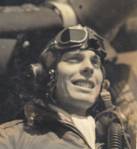
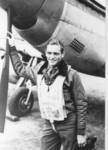
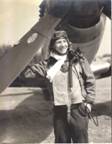

|
| Capt. Lancaster – Lt. Williams – Lt. Baker – Lt. Rabb |
Nearing the target Lt. Williams was unable to maintain contact with the flight. Captain Lancaster's aircraft's engine began to loose power and oil pressure. Captain Lancaster alerted the remaining two pilots in his flight of his problems. Lancaster's aircraft's engine then failed. He elected to divert to Neutral Sweden. Captain Lancaster's remaining wingmen, Lt.'s Rabb and Baker stayed with him until they were assured he could glide to neutral territory. Captain Lancaster was able to crash land in Sweden and was initially interred at Holviken, Sweden.
Lt.s Rabb and Baker headed home. Along the way they were attacked by a German Bf 110. After a lengthy fight they shot down the Bf 110. Now low on fuel themselves and unable to reach England both Rabb and Baker diverted to Sweden and were interned at Ljungbyhed, Sweden.
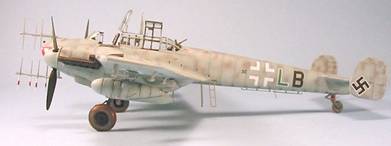
Messerschmitt Bf 110G-4
All three airmen were flown back to the UK on November 1, 1944. Per the Geneva Convention they were no longer to participate in the European Theater. Captain Lancaster ended the war in the USA as an Instrument Instructor on North American AT-6's.
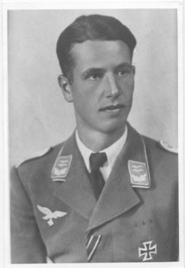 Recently the local historian in the village of Slimminge, Denmark, Mr. John Frederiksen, pieced together more of the story of the events that day. It seems that after Lancaster had crash landed in Sweden and Lt.s Rabb and Baker headed towards England they were picked up on German radar. Incorrectly identified as a lone B-17, German authorities scrambled a Messerschmitt Bf 110G-4 to intercept. This Bf 110 s/n 720251 code G9+HX, flown by Hauptman Baron Fritz von Bucholtz seen in the photo to the right, was radar equipped and was usually employed as a night fighter.
Recently the local historian in the village of Slimminge, Denmark, Mr. John Frederiksen, pieced together more of the story of the events that day. It seems that after Lancaster had crash landed in Sweden and Lt.s Rabb and Baker headed towards England they were picked up on German radar. Incorrectly identified as a lone B-17, German authorities scrambled a Messerschmitt Bf 110G-4 to intercept. This Bf 110 s/n 720251 code G9+HX, flown by Hauptman Baron Fritz von Bucholtz seen in the photo to the right, was radar equipped and was usually employed as a night fighter.
The Bf 110 was vectored toward the contact by radar with the rendezvous made over the village of Slimminge. Imagine the surprise when Hauptman von Bucholtz encountered two P-51 Mustangs. During the ensuing dog fight the Bf 110 was severely damaged, more than likely by Lt. Baker. Hauptman von Bucholtz ordered his crew to bail out and Unteroffizier Rudi Freund and the Engineer parachuted to safety. Baron von Bucholtz was killed in the crash and was buried in the Vestre Cemetery in Kobenhavn.
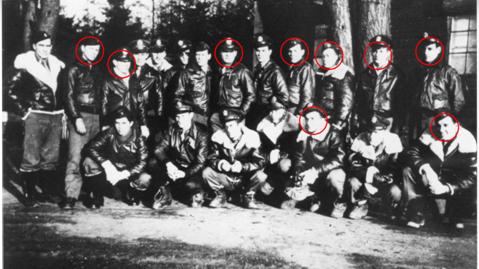
Original Pilots of the 370th Squadron of the 359th Fighter Group
Of the Twenty Pilots in this photograph seven were Killed In Action,
One was Interned in Sweden and one was a Prisoner Of War – A loss rate of 45%.
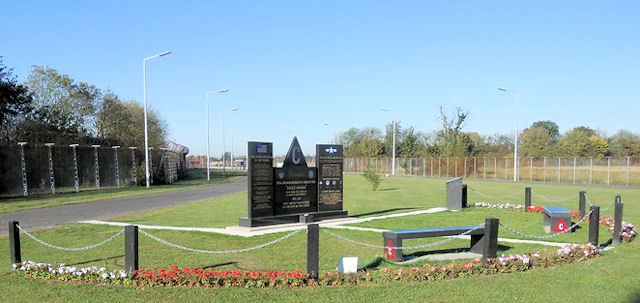
The newly refinished 303rd Bomb Group Memorial was rededicated this week. Watch for the story and photographs in the next issue. The preview photo is courtesy of Chris Hughes.
|
Home of the 303rd Bomb Group (Heavy)
 Veterans and family members of the 303rd Bomb Group are able to visit the home of the 303rd at RAF Molesworth located near Huntingdon, Cambridgeshire, England some 80 miles northwest of London.
Veterans and family members of the 303rd Bomb Group are able to visit the home of the 303rd at RAF Molesworth located near Huntingdon, Cambridgeshire, England some 80 miles northwest of London.
As RAF Molesworth continues as an active U.S. Base today with an important mission, admission to the base is necessarily strictly controlled for security reasons. 303rd family members wishing to visit may contact the base historian Mr. Peter Park at peter.park@jac.eucom.mil who can advise on military entry procedures, information needed from potential visitors, and possible visit dates. |
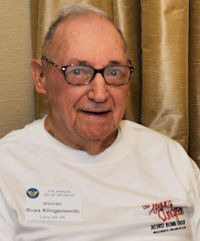 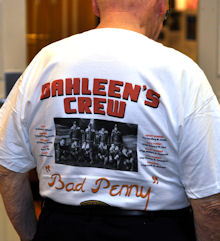 |
359th BS Navigator
We were aboard Scorchy heading for Frankfurt, Germany on February 11, 1944. Before we reached the target, flak knocked out two engines and a wing fuel tank. We dropped out of formation and turned for home. We decided to do something worthwhile with our bomb load.
Our pilot, Howard Dahleen, took us over a rail line and Ray Gauthier, the bombardier, laid down a string of 500-pound bombs making a real mess of about a quarter-mile of track. Our air speed was only about 90 knots when two German fighters came up, looked us over, and for whatever reason went back down.
Our fuel was so low that we made preparations to ditch in the channel. Once we reached the Belgium coast, Howard decided to try to make it to England and an RAF Spitfire base at Shoreham.
We landed, but our hydraulics were gone and our brakes failed. Scorchy crashed into a building and an anti-aircraft gun emplacement and broke in half at the radio compartment, with the tail section ending up behind the left wing.
Cliff Swanson, our radio operator, went tumbling onto the ground, shaken up but not seriously hurt. Our engineer, Orrick Malcolm, suffered a separated shoulder. Other crew members had minor cuts and bruises. Minor, that is, when you figure it was a crash none of us might have walked away from.
![]()
by Patti Yost
Recently I had a wonderful opportunity sit and speak with TPCA resident Tom Hardin (Thomas H. Hardin, Jr. Major USAF Retired). Tom has been a resident in Timber Pines since 1990 and resides in Manor Place. Recently, Tom shared some proud facts of his life with me...
Tom Hardin is one of three generations to serve our great country. Tom was a B-17 pilot with the 303rd Bombardment Group. He flew combat missions over enemy occupied European territory during World War II. In 1947 he married Mae Belle. Mae Belle served four and a half years in the Women's Army Corps as an air traffic controller. Tom was assigned to the 98th Bombardment Wing flying B-29's on bombing missions over North Korea in 1950. His awards and decorations are many...Command Pilot Wings (the highest pilot rating awarded by the USAF); Distinguished Flying Cross; seven Air Medals and eight Bronze Battle Stars.
He is quite proud of the next two generations...
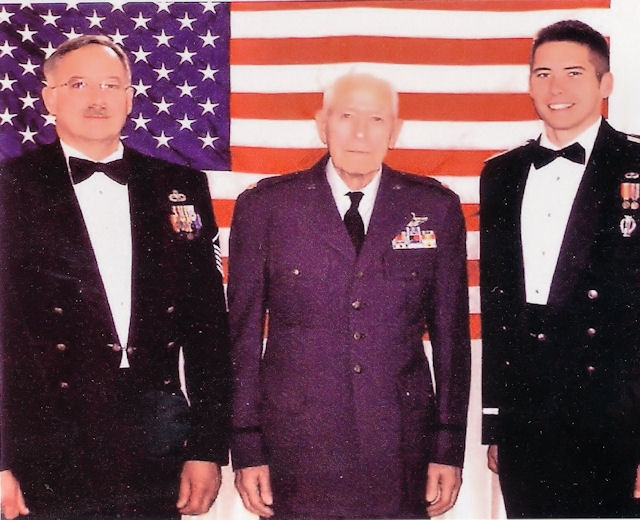
Pictured above from left to right are Scott A. Hardin, Thomas H. Hardin and James E. Hardin
Scott A. Hardin, Master Sergeant, USAF Retired. Scott spent ten years maintaining and operating four different flight simulators: FB-111A, RF-4C Phantom, F-15 Eagle and F-16A Falcon. For fourteen years, he then worked on computerized test equipment supporting the F-16 & F-117 aircraft. He is currently developing courseware in support of aircrew training for the Air Force unmanned aircraft (remotely piloted vehicles), the MQ-1 Predator and MQ-9 Reaper, presently flying combat sorties in the Middle East.
James E. Hardin is Tom's grandson and Scott's son. He is presently a Lieutenant in the USAF. James is a graduate of the United States Air Force Academy, class of 2010. His present assignment is with the 341st Missile Wing at Malmstrom Air Force Base in Great Falls, Montana. This base is one of three Air Force bases that maintain Minuteman III Intercontinental Ballistic Missiles. Lt. Hardin spends much of his duty in an underaround facility with access to ICBM controls.
A funny anecdote... Major Hardin's wife, Mae Belle, enjoyed flying as a passenger. In 1945, she was returning to Texas from her home in Alabama when the pilot encountered bad weather and his radio was inoperative. Flying above an overcast sky and unable to contact anyone for assistance, they were lost for over two hours. At 2:30am, the fuel ran out and the pilot ordered his passenger to bail out. Mae Belle says she was VERY scared! They got lost over Texas and landed safely in Oklahoma.
In 1992 the pilot and his wife spent three days with the Hardin's in Timber Pines. During their visit, the pilot commented to their daughter..."I almost killed your mother".
![]()
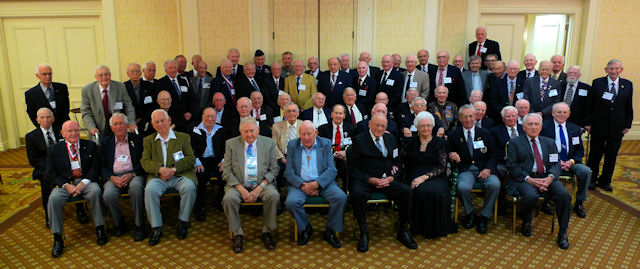
About 70 veterans attended the 2011 8th Air Force Historical Society Reunion in St. Louis.
This Group Photo, taken October 16, 2011, is courtesy of Craig Dubishar.
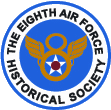
The 8th Air Force Historical Society is planning their next reunion for San Antonio, Texas. It will be at the Crown Plaza Hotel on the Riverwalk, October 3-7, 2012. Mark your calendars!
Found at a Flea Market in Germany
(submitted by G.L. Fegette)
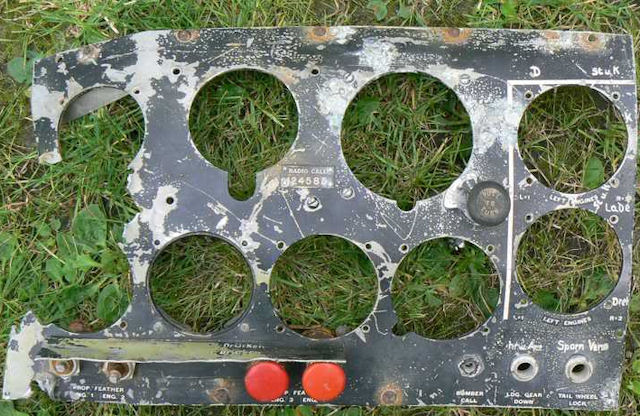
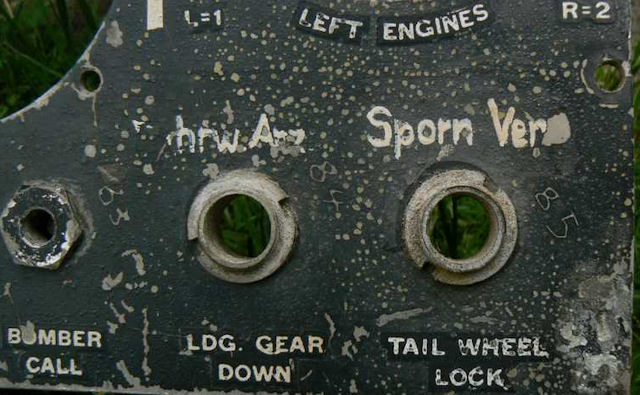
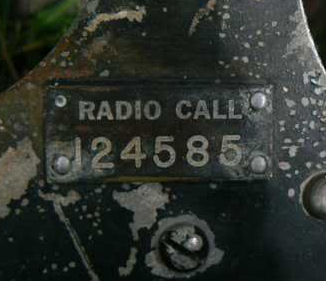 At first, I didn't believe it : an original B-17 instrument panel (well at least the most important part of it).
At first, I didn't believe it : an original B-17 instrument panel (well at least the most important part of it).
But after closer examination, yes there it was : the original central instrument panel of "Wulfe Hound", a B-17F of the 303 BG that had made a forced landing in the Netherlands in December 1942 It became the first B-17 captured intact by the Luftwaffe and was thouroughly used by them to better assess weak points of the "Flying Fortress". It was later transfered to KG 200.
As my German is close to zero, I only understood from the seller that it was found with other aircraft parts (unfortunately scrapped) close to Berlin around two years ago, during a cleaning operation carried out by the army.
So we better keep searching !!!!
[author unknown: photos and text found in a WWII discussion forum]
![]()
 Julius E. (Sam) Bass, Lt. Colonel USAF Ret. of Merritt Island, Florida died quietly on Tuesday, Oct. 11, 2011.
Julius E. (Sam) Bass, Lt. Colonel USAF Ret. of Merritt Island, Florida died quietly on Tuesday, Oct. 11, 2011.
Funeral services were held at 3 p.m. Saturday, Oct. 15, 2011, at Florida Memorial Funeral Home in Rockledge, Fla.
He was born in Moselle on Sept. 28, 1918 and grew up in Laurel. His parents were C. Asco Bass, Sr. and Viola Dunigan Bass. He was preceded in death by his parents; one sister, Jewel Grace Bass; and two brothers, Lester R. Bass and C. Asco Bass, Jr.
He is survived by his loving wife of 68 years, Mary E. Taylor Bass; one son, John Bass and his wife, Rita of Leland, N.C.; one brother, Jimmy Bass and his wife, Ann of Laurel; one sister, Bobbie Bass Pope of Laurel and many beloved nieces and nephews.
He was devoted to his country, serving as a B17 pilot in the 358 Bomber Squadron, 303rd Bomb Group of the Mighty 8th in World War II, during which he survived being shot down over Bricey, France and resulting imprisonment. He and his crew received many military awards for their service. Additionally, Julius also received the Purple Heart.
Following his retirement from the military he worked for Delta Airlines and Insight Tours.
He was an inspiring natural born leader of men and was known for his kindness and generosity toward others. Anyone who had the good fortune to know Julius would always come away with the same impression....it was an honor and a privilege to know him.
One of his surviving crew members still clearly and loudly states today “He is my Captain...my Captain....he will always be my Captain!”
His presence will be truly missed by all.
Florida Memorial Funeral Home in Rockledge, Fla. was in charge of arrangements.
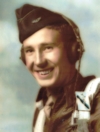 Philip Archie Peed, 89, lifelong resident of Roswell, passed away Saturday morning in his sleep. Philip was the son of Dread and Willie Dee Peed, and was preceded in death by his brothers Lawrence, John, and Howard, and his sisters Alma and Sybil.
Philip Archie Peed, 89, lifelong resident of Roswell, passed away Saturday morning in his sleep. Philip was the son of Dread and Willie Dee Peed, and was preceded in death by his brothers Lawrence, John, and Howard, and his sisters Alma and Sybil.
Philip was born November 8, 1921 in Roswell, and graduated from Roswell High School where he was a standout in football, and an All-State basketball player. After high school, he worked for local clothiers The Model and Ball and Ray. In 1942, he entered the Army Air Corps where he trained as a pilot; however, he was unable to complete his pilot training and was certified as a bombardier on B-17 aircraft. Sent to Germany as part of the 8th Air Force/303rd Bombardment Wing, Philip flew 6 missions against the Nazi regime until his plane was shot down on ‘Black Thursday’ – Oct. 14, 1943 – in the infamous raid on the ball bearing factories of Schweinfurt. He was captured by the Germans and spent 18 months as a POW until liberated by forces under the command of Gen. George Patton. During his internment, Philip took classes taught by fellow inmates in accounting and bookkeeping, which became his vocation for the rest of his life.
After the war, Philip returned to Roswell, where he married Leola Smith. He worked in Roswell as general manager and bookkeeper for Bill Deane Tire Company, moved to Farmington for a few years where he was general manager for Beeco Tire Company until becoming a full-time accountant and returning to Roswell to work for Deason, Crocker, Singleton and Peters. Though Philip never went to college, he gained so much practical accounting experience that he became a Registered Public Accountant, and then went on to be a CPA – the equivalent of earning a Master’s degree. When Philip’s father-in-law Harold Smith passed away and left a working cattle ranch to his wife Claribel , Philip took over as manager, overseeing the operation, keeping the books, and working the cattle on the weekends while he continued his accounting work. He was selected as Outstanding Rancher in 1992 by the Border Soil and Water Conservation District; however, the drought necessitated the sale of the ranch in 1993. He retired from accounting in 1993 and spent his retirement playing golf (where he was known as Fairway Phil) gardening, woodworking, and being caretaker for his mother-in-law and his two sisters as they neared the ends of their lives.
Philip was well-loved by many in the Roswell community, had a magnetic, loving personality, a servant’s heart, and never met a stranger. He is survived by his beloved wife of 66 years, Leola Smith Peed, daughter Sharon O’Bryant of Ruidoso, son John Peed of Suwanee, GA, his brothers Harold and Robert, seven grandchildren, and fifteen great-grandchildren. He will be missed.
Memorial Services will be held at 10:00 A.M., on Tuesday, October 18, 2011 at LaGrone Funeral Chapel. Military honors will be conducted by the Roswell Veteran’s Honor Guard. In lieu of flowers, the family requests that memorials be made to the Alzheimer’s Association, NM Chapter, 404 ½ S. Kentucky, Roswell, NM 88201.
 James K. Sadler, 91, of Gatesville passed away on Saturday, October 1, 2011 in Gatesville.
James K. Sadler, 91, of Gatesville passed away on Saturday, October 1, 2011 in Gatesville.
Mass of Christian Burial will be held at 10:00 AM on Tuesday, October 4, 2011 at Our Lady of Lourdes Catholic Church in Gatesville, with Father Timothy Vaverek officiating. There will be a Rosary at 6:00 PM on Monday, October 3, 2011 at Scott’s Funeral Home Chapel.
James K. Sadler was a hero to his family. He was born in Killeen, Texas on October 6, 1919 to C.K. and Currie Polk Sadler. James was reared on the family ranch in what is now Ft. Hood reservation. James graduated from Gatesville High School and served with the United States Army Air Corps from 1942-1945. James was with the 8th Air Force, 358 Bomber Squadron where he was a gunner flying on B17 bombers. James was wounded in combat, decorated with the Distinguished Flying Cross, Purple Heart and Air Medal. He was discharged in 1945 with the rank of Sergeant.
After the war, James began a long career with the Mobil Oil Company. He began his employment with Mobil in South Texas, then transferred to Venezuela in 1952 and had a distinguished career with Mobil. In 1978, the Venezuelan National Oil Company was formed. James had established his home in Venezuela so he stayed and worked with the Venezuelan Oil Company until his retirement in 1992. James service to the Venezuelan Oil Company was recognized when he was awarded the highest honor given by the Venezuelan Government.
James married his wife, Magali in Venezuela and was rewarded with a loving wife and large family. In speaking with family, these memories stood out for his brothers and sisters. They always thought of James’s service in WW II, he was a hero in their life and all were very proud of his service. Even more gratifying is the repeated times his family depended on James as the person in their life they trusted to make things right. His love and caring spirit represents the best in all of us.
He is survived by his wife Magali Sadler, three children, Diema, and husband Ricardo of Key Biscayne, Florida; Dielly of San Francisco, California; Diego of Barcelona, Spain; and five grandchildren, Gabriel, Julia, Daniel, Sophia and Maya. He’s also survived by his siblings, Edwin Sadler of Magnolia, Sara Larrimer of Gatesville, Jane Jones, and husband Bobby Jones of Gatesville; Bill Sadler, and wife Barbara Sadler of Marble Falls, Bob Sadler, and wife Carolyn Sadler of Fort Stockton, Texas; and numerous nieces, nephews and cousins. He’s also survived by the wonderful staff of the C wing at The Meadows Nursing Home.
 Michael "Mike" Klym, 89, of Mattydale, passed away peacefully at the Veterans' Hospital, Sunday Oct. 9, 2011. He was born in Syracuse to the late John and Katherine Klym and graduated from Vocational High School. He resided in Mattydale for 63 years, summered on Sixth Lake, Inlet, NY and was a member of St. Margaret's Church.
Michael "Mike" Klym, 89, of Mattydale, passed away peacefully at the Veterans' Hospital, Sunday Oct. 9, 2011. He was born in Syracuse to the late John and Katherine Klym and graduated from Vocational High School. He resided in Mattydale for 63 years, summered on Sixth Lake, Inlet, NY and was a member of St. Margaret's Church.
He was employed by Lipe Rollway Corp as a toolmaker for over 50 years and had been tool room foreman for many years.
During WWII, he served in the Army Air Forces in the European Theater of Operations. A Tech Sergeant and top turret gunner on a B-17, he flew 33 missions with the 303rd bomber squadron. Surviving are his wife of 65 years, the former Jean I. Congdon; a son, David (Carolyn) of Rockville, MD; a daughter, Karen (Gabrielle) of Melbourne, Australia; three grandchildren, Wade (Tracey) of Baltimore, MD, Donald (Michelle) of West Columbia, TX and Christine (Joseph) of Temple, TX; four great grandchildren, Hunter, Austin, Cameron and Madison; a sister, Mary Robertson and several nieces and nephews. In addition to his parents, he was predeceased by his brothers, Walter and Joseph and a sister, Anna.
Services: 9:30 a.m. Thursday Oct. 13 at Fergerson Funeral Home and at 10 a.m. at St. Margaret's Church, Mattydale, with burial following in Assumption Cemetery. Calling hours: 4 to 7 p.m. Wednesday Oct. 12 at Fergerson Funeral Home, 215 S. Main St., North Syracuse.
The family wishes to extend their thanks to the physicians and staff of the VA Hospital 6th floor south for their compassionate care of Mike.
![]()
Gary,
Attached is a photo that I hope will be of some interest to you and others who are associated with the 303rd Bomb Group. I am the son of John W. Tulloss who flew for the 303rd. Going through some of his war memorabilia, I came across this glove. At one time it was a full size flight glove, but as you can see from the photo it is now smaller than a dollar bill. The note my dad left with the glove reads as follows:
"Glove worn by Lt. Goering when his B-17 crashed on take-off from Molesworth, England on bombing mission in 1944. Plane was landed with bombs & caught on fire. All crew (10) escaped without injury, but the intense heat shrunk this glove to this size. 303rd Bomb Group/359th Squadron."I, of course, would have no way of knowing if Werner Goering is alive and would be interested in this piece of history. Maybe the 303rd would be interested in preserving the glove. Give me a shout and let me know your thoughts. If Mr. Goering is alive and has an interest in the glove, I'm sure my dad would be glad that he have it and I would be delighted to be instrumental in getting it to him.Be well.
Jack Tulloss
Gary,
Thanks for your article in your newsletter, very well written and it will mean a lot to us... forever...
Thanks again,
Tom Gobrecht
Gary, my sincerest appreciation for continuing this great mission. You are truly serving out one of the purposes of your life in keeping the lives of our heros and their bravery alive.
Gwen Gollotte, Sister of Victor Gilbert Hand
I am so thankful that Lt. Ehle Reber is being honored by having the Malin airport renamed for him. My brother Victor G. Hand served with him and lost his life when Lt. Reber's plane went down. I wish that I could attend the dedication but that is impossible. My prayers will be with those participating in this occasion.
Jeanne Hand Henry
Sister of Victor G. Hand
Gary:
Today I talked to Ed Nelson. He was very happy when I told him about pictures of Buzz Blonde. I will send them to him tomorrow. Reading the story more carefully today I read Walt Mayer was on that mission. Another was Tony Zelnio who lived in Moline, right next to us, flew that day too. I worked in the Post Office with his older brother.The Molesworth Pilot keeps us in contact.
Thanks, Al Dussliere
Keeping the Legacy Alive,

|